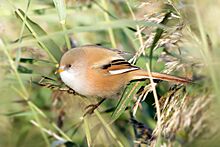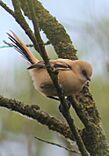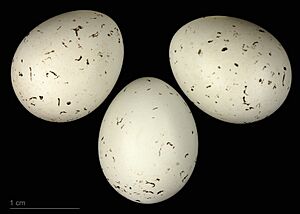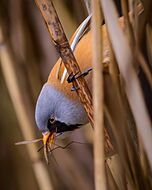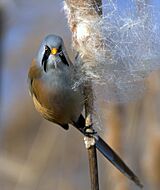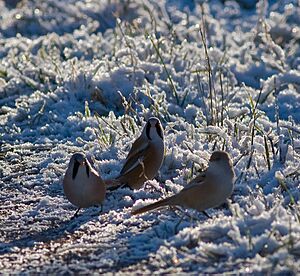Bearded reedling facts for kids
Quick facts for kids Bearded reedling |
|
|---|---|
 |
|
| Adult male in Gelderland, the Netherlands | |
| Conservation status | |
| Scientific classification | |
 |
|
| Where the bearded reedling lives (green is resident, blue is non-breeding visitor)
Resident Non-breeding visitor |
|
| Synonyms | |
|
The bearded reedling (Panurus biarmicus) is a small bird with a long tail. You can find it in reed beds near water in parts of Eurasia. It's often called the bearded tit or bearded parrotbill. This is because people once thought it was related to tits or parrotbills. But now we know it's unique! It's the only species in its own family, called Panuridae.
Bearded reedlings look different depending on if they are male or female. They form pairs that stay together for life. These birds can have many babies, breeding several times each season. In summer, they mostly eat small bugs. In winter, they switch to eating plant seeds.
Contents
About the Bearded Reedling's Family Tree
The bearded reedling was first described by a Swedish scientist, Carl Linnaeus, in 1758. He first put it with the tits. Later, scientists moved it to other bird families. But new studies show it's very special. It doesn't fit with any of those families.
So, the bearded reedling now has its own family, Panuridae. This family was named in 1860. It doesn't have any close relatives. But it is most similar to the lark family. These two bird families separated a very long time ago.
The name Panurus means "exceedingly tail" in Ancient Greek. This refers to its long tail. The name biarmicus comes from an old place name, Biarmia. This was a mistake, as the bird doesn't live there.
Different Types of Bearded Reedlings
Scientists usually recognize three main types, or subspecies, of bearded reedlings:
- P. b. biarmicus: This type is medium-dark. It lives in northern, western, and southern Europe. You can also find it in Turkey and Azerbaijan.
- P. b. russicus: This type is paler. It lives in eastern Europe, Russia, and Central Asia. Its range extends to Mongolia and northern China.
- P. b. kosswigi: This type is dark. It lives in southern Turkey and likely in nearby Syria.
These three types are quite similar. Some experts think they might not be different subspecies at all. This is because individual birds can vary a lot.
Where Bearded Reedlings Live and Their Home
The bearded reedling lives in temperate parts of Europe and Asia. Its home stretches from Spain to China. But they are not found everywhere. They only live in specific places with the right habitat. Maps often show their Asian range as one big area. This is because we don't have as much detailed information from there.
In Europe, they used to live only in warmer, southern areas. But in the last half of the 1900s, they moved north. Now they live in Scandinavia and Finland too.
Sometimes, they visit places like Cyprus and Iran. Very rarely, they fly far from their usual homes. This has happened in Portugal, Japan, and Korea. These birds usually stay in one place all year. They don't have a clear migration pattern. However, some European birds fly south for the winter. This is a short trip, only a few hundred kilometers. It mostly happens in northern Europe. Not all birds do this; some stay put. Both young and adult birds might move around if food is scarce or it's very cold.
Bearded reedlings are very picky about their home. They live in reed beds, especially those with common reed. These are found by fresh or slightly salty lakes, swamps, or rivers. They also live in tall, grass-like plants nearby. During breeding season, they avoid dry areas. They usually perch on reeds. But they can also hop on the ground, especially in wet places. They live from sea level up to high mountains in China.
What Bearded Reedlings Look Like and Sound Like
This is a small bird, about 14.5 to 17 cm long. It has a long tail and flies with a wavy motion. Its body is mostly orange-brown. It has a white throat and chest. Its wings have black and white parts. The tail feathers have white edges.
Adult males have a grey head. They have black "moustaches" (not a beard!) and black feathers under their tail. Adult females are usually paler. Their heads are more brownish. They don't have black moustaches or black undertail feathers. But some females have black streaks or spots on their head or back. The female's beak is often duller than the male's bright orange-yellow beak.
Adults change all their feathers in late summer or autumn. This usually starts in August after breeding. It finishes about 50 days later.
Young birds of both sexes look like the adult female. But they are more buff in color. They have a black patch on their back. Their tail feathers are very black. Young males have a large, black patch near their eyes. Their beak is bright orange-yellow. Young females have a smaller, greyish patch near their eyes. Their beak is blackish, brownish, or yellowish-grey. This difference in beak color shows up even when they are still in the nest.
Unlike most birds, young bearded reedlings change all their feathers. This happens from late July to early September. By October, they look just like adult birds. When they first leave the nest, their eyes are dark brown. Then they turn grey, then grey-yellow or yellow. Once they have adult feathers, their eyes are usually yellow or orange.
These birds are hard to see because their feathers blend in. They also live in thick reed beds. But you can often hear them. They make a metallic "ping" sound. This helps them stay in touch with each other. The male's song is a pretty "tschin-schik-schra." When they fly, their short wings make a whirring sound.
Bearded Reedling Behavior and Life Cycle
Social Life and Pairing
Bearded reedlings are social birds. When it's not breeding season, they gather in groups. These groups can have a few dozen birds, sometimes even two hundred. During breeding season, you usually see them in pairs or family groups.
Young birds find a partner when they are still young. Once they pair up, they usually stay together for life. They even sleep close together. If one bird in a pair dies, the other might join young groups to find a new partner. A pair usually mates only with each other. But mating with other birds can happen.
The length of a male's black "moustaches" shows how strong he is. Males with longer moustaches usually win food fights. Females prefer males with longer moustaches. Both sexes also like partners with longer tails. A longer tail helps them move better.
Reproduction and Nesting
Bearded reedlings breed in spring and summer. This is from late March to early September. The exact timing depends on food and weather. April to July is a common time. They usually have two or three groups of babies each season. Sometimes they have four, and rarely five. In zoos, they might start breeding earlier. They might even try to have up to seven groups of babies.
A pair might nest alone. Or they might be part of a small group of nests. These groups usually have about six pairs. Their nests are a few meters apart. In these groups, it's common for birds to mate with more than one partner. This often happens when a female makes a special call. This call attracts males. She then flies up with males chasing her. She dives into the reeds, and the fastest male mates with her. This can be her own partner or another male.
Both male and female birds help build the nest. It's shaped like a cup and is 7.5 to 17 cm wide. They attach it to reeds or similar plants. The nest can be close to the ground or water. It can also be up to 0.7 meters high.
Both parents also help hatch the eggs. There are usually 4 to 8 eggs, but sometimes 3 to 11. This takes up to two weeks. After the eggs hatch, the babies stay in the nest for another two weeks. Young birds often leave the nest before they can fly well. They still rely on their parents for about two more weeks.
From building the nest to the young being fully independent takes about 40 days. Sometimes, a pair will start a new nest nearby. They might do this even before their last babies have left the old nest. If this happens, the female focuses on the new babies. The male helps both the old and new babies. In good years, a pair can raise more young than almost any other European songbird. Young birds grow up fast. Those born early in the season might breed later that same year. But this is rare. They usually breed for the first time the next year.
Bearded reedlings usually live for two or three years. The oldest one ever recorded lived for seven years and three months.
What Bearded Reedlings Eat
In the summer, bearded reedlings mostly eat insects. They eat adult insects, their larvae, and pupae. They also eat other small bugs like spiders and snails. They tend to pick slow-moving bugs. Parents feed these same foods to their babies. Often, the nest is far from where they find most of their food.
In late autumn and winter, they mostly eat seeds. They eat seeds from common reed, rushes, and other grass-like plants. Sometimes, they join groups with other small seed-eating birds. They pick seeds directly from plants or from the ground. They might scratch the ground, flip over leaves, or even dig in snow.
But in harsh or wet winters, it's hard to find seeds. Heavy snow, ice, or floods can cover their food. This can cause birds to starve. Their bodies change to handle these different diets. Their stomach lining gets stronger. From September to December, they swallow small stones or gravel. This helps them grind down tough seeds.
Bearded Reedling Conservation Status
Overall, the bearded reedling is found in many places. It has a large population. So, it's not considered in danger. In Europe alone, there are about 500,000 or more adult birds. Most of the species lives in Asia. So, the total number of adults is probably at least 3,000,000. But it's hard to count them accurately. This is because of how they live.
The number of birds in local areas can change a lot each year. This depends on food and habitat. Hard winters can kill many birds. But even if all birds in an area die, new ones can move in later. This is because they have many babies and can spread out. In some places, their homes have been lost. This has caused populations to drop or disappear. One type, P. b. kosswigi, hasn't been seen since 1962. It might be extinct.
Bearded reedlings can spread to new areas. For example, they started breeding in Denmark and Sweden in the late 1960s. Now they are common there. This was part of a bigger spread in northwestern Europe. It seems to have come from the large population in the Netherlands. In later years, they spread further north. They reached Estonia in 1978 and Finland in the late 1980s. With global warming, they might spread even more. This is because winters are becoming milder. But more extreme weather, like droughts or winter floods, could harm some populations.
In the United Kingdom and Ireland
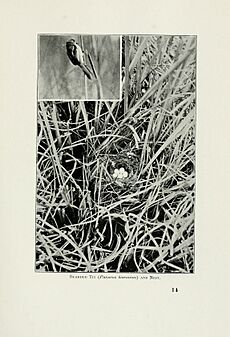
The number of bearded reedlings in the UK has always changed a lot. This depends on how harsh winters are. It also depends on how much reed bed habitat is available. People used to harvest or drain these reed beds. Collecting their eggs also played a role.
Up to the early 1900s, the bearded reedling population went down. This was due to habitat loss and hunting. After several hard winters in the 1930s and 40s, their numbers crashed. Only a few birds survived in southeastern England. After the very harsh winter of 1946–47, almost all of them died. The next summer, there were only about six pairs left in Norfolk and Suffolk.
After this, the population started to grow. It was thought that birds from Europe helped. In 1965, birds tagged in the Netherlands were found in Great Britain. This proved they could cross the English Channel. Since then, the British population has grown a lot. They are found in more places and in larger numbers. But they are still uncommon and live in specific spots. There have been a few more crashes. These were likely due to hard winters. But none were as bad as the 1930s–40s crash. And the birds recovered quickly.
As of 2019, most of the UK's almost 100 known breeding sites are in England. England has more than 500 pairs. They are mainly in southern and eastern England. But there are a few sites in the North West. In Scotland, there are only three known breeding sites. All are in the east. The largest is at the mouth of the River Tay. It has over 250 pairs. In Wales, they disappeared as breeding birds in the early 1980s. They returned in 2005 in Gwent. This is still the only place they are known to breed there.
In Ireland, the bearded reedling was once a rare visitor. But in recent years, they have been confirmed breeding. This is in coastal southeastern parts of the island. There has been a small breeding population in County Wexford since 2011. And likely in County Wicklow since 2017.





